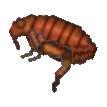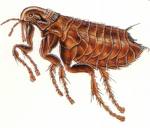Flea
| ||||||
 | ||||||
| Real-world info | ||||||
|---|---|---|---|---|---|---|
| Name: Pulex irritans Family: Pulicidae- Fleas | ||||||
| Main appearances | ||||||
|
| ||||||
| Other appearances | ||||||
Names in other languages
ノミ
벼룩 Pulce Floh
跳蚤
Puce Pulga Vlo
跳蚤 Puce Pulga Блоха | ||||||
The Flea is a bug in the Animal Crossing series introduced in Doubutsu no Mori e+. They can be found on villagers from spring to early winter. In Animal Crossing: New Leaf, Fleas are more common than they are in the previous Animal Crossing games. They appear as black, hopping specks.
When villagers have Fleas, their catchphrase changes to one of a variety of catchphrases, such as "eesh itchy" or "yowiezowie," which indicates that they are itchy. This catchphrase changes each time it is used in dialogue. Once the Flea has been caught, the villager that played host to it will give a response, usually one of denial, shock, or gratitude, depending on their personality.
Catch details
In Doubutsu no Mori e+
In Doubutsu no Mori e+, Fleas cannot appear on alligator, anteater, duck, elephant, frog, hippo, octopus, penguin, or rhinoceros villagers. They also cannot appear on villagers with normal or snooty personalities.
In Wild World
| Description | The female flea lays up to 20 eggs a day, and is usually larger than the male. Gross! |
|---|---|
| Time of year | Mar – Nov |
| Time of day | All day |
| Peak times | N/A |
| Location | On villagers |
| Bug size | 2 mm |
| Selling price | |
| Furniture size |
In City Folk
| Description | Females can lay up to 20 eggs a day and are usually bigger than the males. |
|---|---|
| Time of year | Mar – Nov |
| Time of day | All day |
| Peak times | N/A |
| Location | On villagers |
| Bug size | 38 mm |
| Rarity | Common |
| Selling price | |
| Furniture size |
In New Leaf
| Time of year | Mar - Nov |
|---|---|
| Time of day | All day |
| Peak times | N/A |
| Location | On villagers |
| Size | 3 mm |
| Rarity | Very common |
| Selling price | |
| Furniture size |
In New Horizons
In New Horizons, Fleas have their own spawning system separate from the standard bug spawning system. They will not be able to spawn on a villager if:
- A Flea has spawned on a villager
- A Flea previously spawned within the last 60 minutes
- The player has not completed the prologue by sleeping on their Camping Cot during their first day
- There is an event or a villager's birthday ongoing
- K.K. Slider is present on the island
- The current date is not at least 7 days past a certain date (likely the creation of the island)
- None of the villagers present on the player's island are valid for a Flea to spawn
If a Flea is able to be spawned, they have a 0.5% or 1.0% chance of spawning in the game.[1]
| Time of year | North: Apr – Nov South: Oct – May |
|---|---|
| Time of day | All day |
| Location | On villagers |
| Weather | Any weather |
| Spawn requirement | Appears from the start of the game |
| Selling prices | |
| Furniture size |
Donating to the museum
As with all insects in the Animal Crossing series, the Flea can be donated to the museum, followed by a small talk by Blathers, the curator.
In Wild World
When donating to Blathers in Wild World, he will provide the following information about the bug:
The Flea can be found near the pond in the first room of the insect exhibit after donation.
In City Folk
When donating to Blathers in City Folk, he will provide the following information about the bug:
Once donated, Fleas appear as a barely-visible speck, bouncing around on the path on the central terrace in the insect exhibit.
In New Leaf
The Flea can be found bouncing around on the upper-left room of the bug exhibit. The following description is given to them:
In New Horizons
When donating to Blathers or selecting "Tell me about this!" in New Horizons, he will provide the following information about the bug:
Gallery
Real-world information
The human flea, Pulex irritans, is a widespread species of flea that is thought to have originated from South America. Despite the name, they are found on all manner of birds and mammals, including dogs, pigs, chickens, monkeys, and even some species of bat. They have powerful legs that can be used to jump incredible heights: roughly 200 times their body length.
Fleas feed on blood. After feeding, females lay eggs on the skin or hair of the host animal. A single flea can have over 500 offspring in its lifetime, which live in the host's bedding feeding on dust and dried blood excreted by their parents after feeding.
Names in other languages
| ノミ nomi |
Flea | |
| 벼룩 byeoruk |
Flea | |
| 跳蚤 tiàozǎo |
Flea | |
| Блоха Blokha |
Flea | |
| Vlo | Flea | |
| Floh | Flea | |
| Pulga | Flea | |
| Puce | Flea | |
| Pulce | Flea | |
References
| Bugs | ||||||||||||||||||||||||||
|---|---|---|---|---|---|---|---|---|---|---|---|---|---|---|---|---|---|---|---|---|---|---|---|---|---|---|
| ||||||||||||||||||||||||||
Cite error: <ref> tags exist for a group named "nb", but no corresponding <references group="nb"/> tag was found






